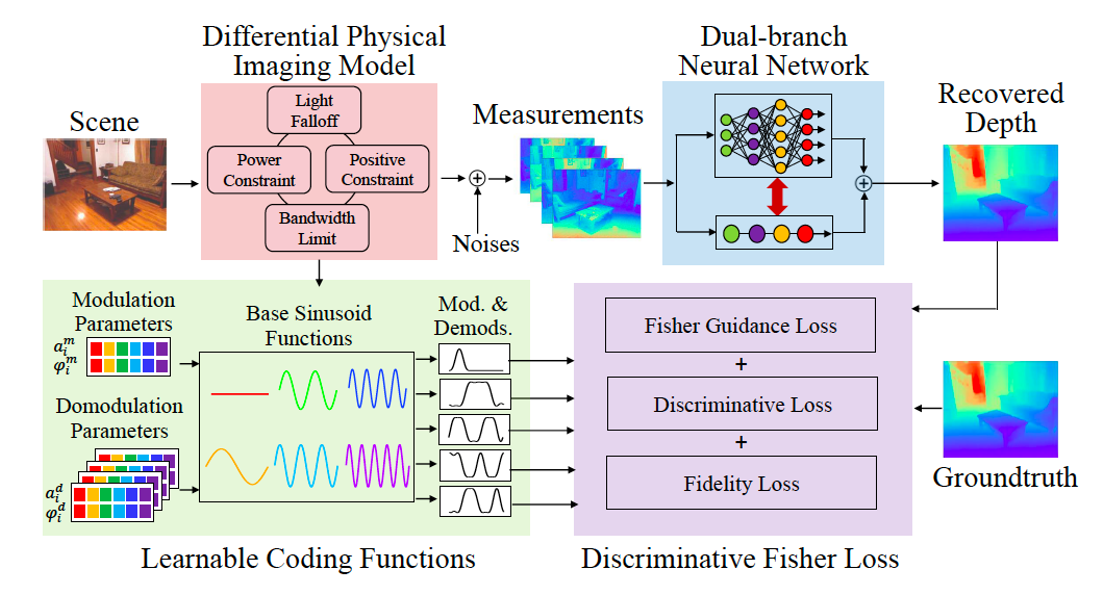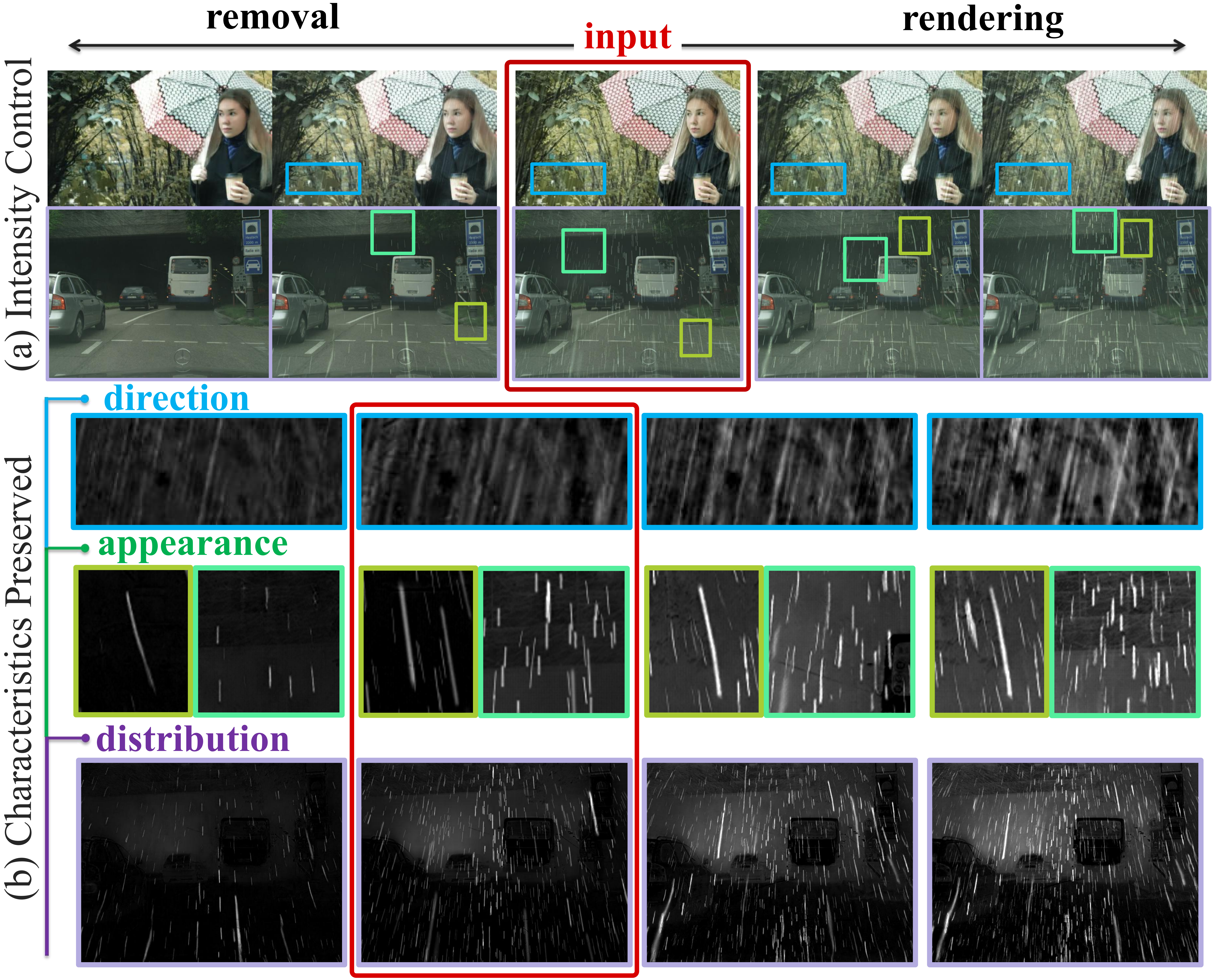 Home
Members
Research
Publications
Home
Members
Research
Publications

Nature Communication
Inspired by the optical structure of trilobite eyes, we demonstrate a nanophotonic light-field camera incorporating a spin-multiplexed bifocal metalens array capable of capturing high-resolution light-field images over a record depth-of-field ranging from centimeter to kilometer scale, simultaneously enabling macro and telephoto modes in a snapshot imaging.

IEEE Computer Vision and Pattern Recognition 2022
In this paper, we propose a Fisher-information guided framework to jointly optimize the coding functions (light modulation and sensor demodulation functions) and the reconstruction network of iToF imaging, with the supervision of the proposed discriminative fisher loss.

IEEE Computer Vision and Pattern Recognition 2022
In this paper, we propose a Fisher-information guided framework to jointly optimize the coding functions (light modulation and sensor demodulation functions) and the reconstruction network of iToF imaging, with the supervision of the proposed discriminative fisher loss.
IEEE International Conference on Computer Vision 2021
In this paper, we design a lightweight disparity estimation model with physical-based multi-disparity-scale cost volume aggregation for fast disparity estimation.

IEEE Computer Vision and Pattern Recognition 2021
This paper proposes to realize continuous control of rain intensity bidirectionally, from clear rain-free to downpour image with a single rain image as input, without changing the scene-specific characteristics, e.g. the direction, appearance and distribution of rain.

IEEE Computer Vision and Pattern Recognition 2021
In this paper, we explore the compression of deep neural networks by quantizing the weights and activations into multi-bit binary networks (MBNs). A distribution-aware multi-bit quantization (DMBQ) method that incorporates the distribution prior into the optimization of quantization is proposed.

IEEE Access 2020
To achieve high sensitivity and resolution, newmeasurement matrices correlating to the incident beam distribution are proposed and the simulation resultsare demonstrated.

IEEE Sensors Journal 2020
In this paper, we propose a novel kind of time delay integration (TDI) image sensor based on single photon avalanche diode (SPAD), i.e. TDI-SPAD.

Optics Express 2019
To fully utilize the redundancies of multispectral videos in the spatial, temporal and spectral dimensions, we propose a Complex Optical Flow (COF) method that could extract the spatial and spectral signal variations between adjacent spectral-sweep frames.

IEEE International Confernce on Computer Vision 2019
We explore the physical origins of the practical high sensitivity noise in digital cameras, and propose to enhance the low light videos based on the noise model by using an LSTM-based neural network.

OSA, Nonlinear Optics 2019
We propose the extended detection and computational reconstruction technique, to extract signals from scattering photons and enhance imaging depths.

Optics Express 2019
In contrast to the spatial filtering based on confocal slit detection, here we propose the extended detection LTFM (ED-LTFM), the first wide-field two-photon imaging technique to extract signals from scattered photons and thus effectively extend the imaging depth.

SPIE 2019
In this paper, we propose a video rate spectroscopy via Fourier-spectral-multiplexing (FSM-VRS) which exploits both spectral and spatial sparsity.

IEEE Photonics Journal 2019
Inspired by the fact that natural scenes exhibit unique degenerated structures in the low-dimensional subspace, we propose to take advantage of such local prior via convolutional sparse coding to implement high fidelity SPI.

IEEE Computer Vision and Pattern Recognition 2019
We propose a simple and low-budget scheme to capture the hyperspectral images with a random mask printed by the consumer-level color printer.

IEEE Computer Vision and Pattern Recognition 2019
We propose a basic theory for capturing multispectral information from a single dispersive-blurred image and an additional spectrum of an arbitrary point in the scene

Optics Express 2018
In this paper, we propose a snapshot hyperspectral imaging technique which exploits both spectral and spatial sparsity of natural scenes.

IEEE Transactions on Image Processing 2018
In this work, we introduce a new approach to RGB+NIR image reconstruction using learned convolutional sparse priors.

IEEE Computer Vision and Pattern Recognition Workshop 2018
We report a resolution-enhanced lensless color shadow imaging microscopy system based on large field-of-view submicron-pixel imaging sensors.

Optica 2018
This paper reviews the context of such cameras in the developing field of computational imaging and discusses how parallel architectures impact optical and electronic processing design.

International Conference on Image Processing 2017
By using a delicately designed chromatic aberration enlarged camera, the spectral-varying slices at different depths of the scene can be easily captured.

Optics Express 2017
In this paper, inspired by anaglyph theory (i.e. the ability of human eyes to synthesize colored stereo perception from color-complementary (such as red and cyan) views), we propose to capture the multispectral light field using multiple cameras with different wide band filters.

IEEE Computer Vision and Pattern Recognition 2016
We propose a sequential, coded-aperture-style acquisition scheme that optimizes the resolution of a light field reconstructed from multiple photographs captured from different perspectives and f-number settings.

IEEE Signal Processing Magazine 2016
This article presents an overview of these state-of-the-art multispectral acquisition systems, with a particular focus on snapshot multispectral capture, from a signal processing perspective.

IEEE Transactions on Circuits and Systems for Video Technology 2016
This paper presents a novel nonuniform deblurring approach, which defines the blur model and calculates regularized nonuniform deconvolution in the wavelet domain to achieve high efficiency and high accuracy.

Optics Express 2016
We propose a content-adaptive computational ghost imaging approach to achieve high reconstruction quality under a small number of measurements, and thus achieve ghost imaging of dynamic scenes.

IEEE Computer Vision and Pattern Recognition 2015
We propose a computational approach for blind aberration removal from a single image, by exploring various geometric and visual priors.

IEEE Computer Vision and Pattern Recognition 2015
We propose an acceleration method to compute the 3D projection of 2D local blur kernels fast, and then derive the 3D kernel by interpolating from a minimal set of local blur kernels.

Optics Express 2015
Inspired by the fact that the natural image patches usually exhibit simple structures, and these structures share common primitives, we propose a patch-primitive driven reconstruction approach to raise the quality of ghost imaging.

Optics Express 2015
Correlation is widely used to reconstruct the object image in ghost imaging (GI). But it only offers a linear proportion of the signal-to-noise ratios (SNR) to the number of measurements. We develop a Gerchberg-Saxton-like technique for GI image reconstruction in this manuscript.

Optics Letters 2014
Ultrafast sources and detectors have been used to record the time-resolved scattering of light propagating through macroscopic scenes. We demonstrate a method of convolutional sparse coding to decompose TLT into direct reflections, inter-reflections, and subsurface scattering.